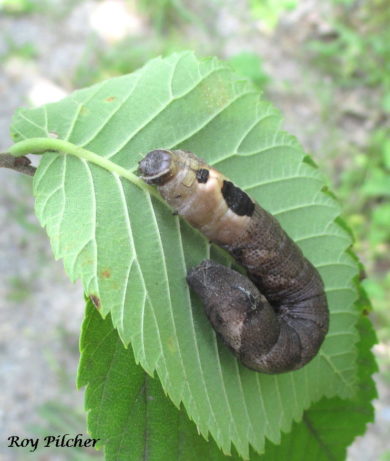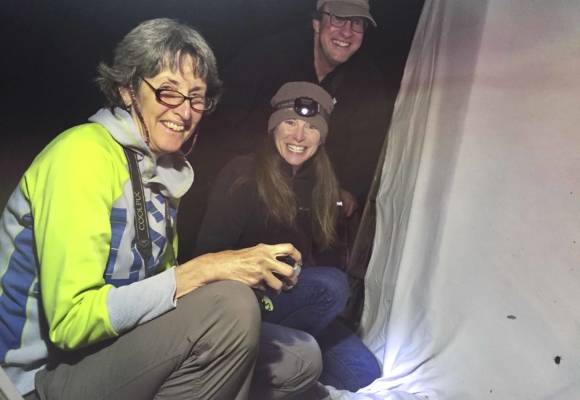
Moths discovered and rediscovered. Melonworm Moth, Hermit Sphinx, and Clouded Underwing (let to right).
The Vermont Atlas of Life, with the aid of many volunteers across Vermont, has been mapping moth distribution and phenology one photo-observation at a time. Since 2013, over 1,475 biologists and naturalists have contributed more than 51,000 moth photo-observations to the Vermont Atlas of Life on iNaturalist. Together, we’ve discovered over 100 new species for Vermont, and just recently, iNaturalists have done it again when two species new to Vermont were discovered and one species that was only known from a historical record was rediscovered.
On September 23rd, moth expert JoAnne Russo photographed a Clouded Underwing (Catocala nebulosa) in Rockingham and shared it on iNaturalist. Most records for this species range farther west and south of Vermont. The larvae feed on Bitternut Hickory (Carya cordiformis), which is found in the major valleys of Vermont and Eastern Black Walnut (Juglans nigra), found in scattered locations in the state.
The next day, iNaturalist Lewis Holmes photographed and shared a Melonworm Moth (Diaphania hyalinata) in Middlebury, another first for Vermont. This moth is also known from farther west and south (although there is one record from Quebec just north of the Vermont border), ranging into South America. In the north, adults fly from September to November. The larvae feed on cucumber, melon and squash. They construct a loose silken structure under the leaves.
And then a long lost moth was rediscovered. In August Susan Elliott, found an adult Hermit Sphinx Moth (Lintneria eremitus) near Rutland and posted it to the Vermont Atlas of Life on iNaturalist. It hadn’t been seen in Vermont since 1991. Then, on October 2, iNaturalist Lisa Maggio posted an image of a caterpillar in Manchester Center on iNaturalist. Although she didn’t know what it was, it was quickly recognized as a Hermit Sphinx Moth by others. It was found on Monarda, one of their host plants that they feed upon. But it turns out, among the more than 350,000 observations submitted to the Vermont Atlas of Life on iNaturalist (and counting!), the Hermit Sphinx Moth was rediscovered two years ago! Roy Pilcher had submitted a photo-observation of a caterpillar in 2017 from West Haven. We’d somehow missed it in the ever-growing database. The good news is that it appears that the Hermit Sphinx Moth, a conservation concern species throughout the region, is back on the map!
Many of us turn on special lights in our backyards on summer nights to find hundreds of moths and other insects gathering on white sheets, hunt fields and forest for day-flying moths, and place rotten fruit bait out to attract other moths. Many of these moths can be identified from good photographs (although some are impossible without dissection and examination under a microscope). With today’s amazing digital photography technology, coupled with the newer Peterson’s Field Guide to Northeastern Moths and web sites like iNaturalist, BugGuide, Moth Photographers Group, or Moths of Eastern North America Facebook Group, moth watching (aka mothing) has become increasingly popular.
Since the 1995 landmark publication Moths and Butterflies of Vermont: A Faunal Checklist, nearly 400 new moth species have been found in Vermont thanks to the tireless efforts of both professional and amateur lepidopterists (we’re updating the faunal checklist of moths now). Preliminary results show that there are now over 2,200 species of moths known in Vermont. And, there are likely many more awaiting our discovery.
We encourage you to add your photographs of moths, too. Finding moths can be as simple as looking for them flying about during the day, or leaving a porch light on and checking it after dark. Serious moth aficionados use special lights and baits to attract them. Check out this short introduction on how to start mothing. It’s easy and fun!



Nice…….
Can someone recommend a guide that displays both the caterpillar and the resulting moth? Do moths go through several stages of instar as a monarch does?
Ruth, Caterpillars of Eastern North America by David Wagner shows most of the adults on the same page with the larvae.
Ruth, yes, moths go thru several instars.